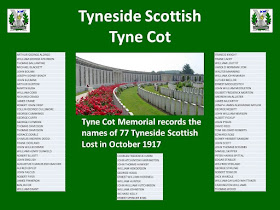Tyne Cot as ever very moving.
The CWGC records 3,587 graves and 34,952 names on the memorial. It is always so peaceful and tranquil, in stark contrast to those who fought and died in the shell torn, gas filled, quagmire that was On th Raod Passchendaele.
The silence as we held a small parade at the Cross of sacrifice and at the memorial wall of the Northumberland Fusiliers (remembering 77 Tyneside Scottish commemorated there) was an opportunity to reflect on the sacrifices made.
There’s a light that shines in Flanders
As a beacon for the brave
From the distant past it wanders
To recall the lives they gave
And it tells each generation
To be wise and never fail
On the road to Passchendaele
 |
| Tyne Cot Cemetery |
 |
| Tyne Cot Cemetery |
 |
| Tyne Cot Cross of Sacrifice |
 |
| Observing two minures silence Cross of Sacrifice |
 |
| Tyne Cot Cemetery |
 |
| Tyneside Scottish Casualties Tyne Cot |
 |
| Tyne Cot Laying wreath on the Memorial Wall |
 |
| Tyne Cot In memorium of 77 Tyneside Scots |
 |
| Tyne Cot October 2012 |
On the Road to Passchendaele
© Alan G Brydon/Major Gavin Stoddart MBE BEM
There’s a light that shines in Flanders
As a beacon for the brave
From the distant past it wanders
To recall the lives they gave
And it tells each generation
To be wise and never fail
On the road to Passchendaele
On the road to Passchendaele
On the road to Passchendaele
Where the brave will live forever
On the road to Passchendaele
Come with me and I will show you
Why all wars should ever cease
Take a walk among the gravestones
And your tears will cry for peace
For their spirits walk in Flanders
You can hear the grieving wail
For the brave who laid their lives down
On the road to Passchendaele
On the road to Passchendaele
On the road to Passchendaele
Where the brave will live forever
On the road to Passchendaele










































